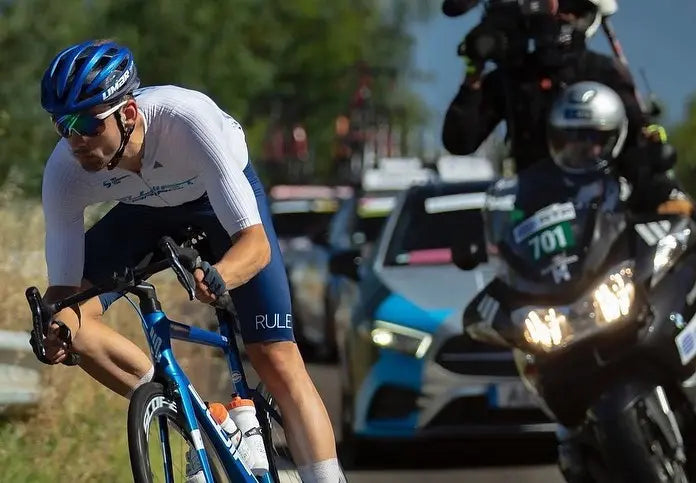Coach Any Turner discusses why focusing on FTP tests can result in worse race day performance and what you can do about it.
FTP has been a talking (bragging) point for cyclists since power meters have gained in popularity. Classic café stop talking points are what someone’s FTP is compared to their mate’s or how much your FTP has gone up by since the last test.
Training plans often focus on boosting your FTP, but how useful is this really? For those that don’t know, Functional Threshold Power is the maximum amount of power a rider can put out over 60mins. This number can either gathered by undertaking a 60 min all-out effort or taking 95% of a 20min effort.
FTP is limited in usefulness however. Training for maximum 20 or 60min power has limited utility in race conditions. It’s all well and good having a great 20+ minute power, but if we can’t follow those critical maximal attacks above ‘threshold’ then we’re unlikely to be winning any races. To learn more about our capacity for those sorts of efforts in addition to our threshold, we need to test and train for something different.
Critical Power
“The critical power (CP) is mathematically defined as the power-asymptote of the hyperbolic relationship between power output and time-to-exhaustion. Physiologically, the CP represents the boundary between the steady-state and nonsteady state exercise intensity domains” Vanhatalo et al., 2011. While Watts Prime (W’) has been described as the finite work capacity above CP.

Figure 1. Shaded blocks equal the W’, all the boxes have the same sized area. The curved line represents the power curve for this rider’s power. The straight line represents CP. Theoretically these lines never touch.
A bit sciencey that explanation, but essentially CP tells us when exercise goes from being sustainable for long durations, to non-sustainable. CP and W’ have become more common testing metrics in recent years for several reasons. They are easier to test than FTP, especially out on the road, and mentally the shorter efforts can be easier to conduct. This form of test also tells you more about your overall power curve as well as your power at non-steady state exercise intensity domains i.e. Full Gas! The test is typically done in one of two ways:
The first way is the 3 minute all out test (Burnley et al., 2006). This means sprinting all out from the gun, with the idea being that the final 30 seconds you will have exhausted your W’ reserve and only be able to ride at your CP. CP is measured as the average power for the final 30 seconds, and W’ is measured as the work done (joules) above CP for the first 2.5 minutes. This test can be difficult to conduct properly as often people leave a little reserve still in the tank and up the power in the final seconds of the effort, skewing the results slightly.
W'
The second method is done by using different lengths of interval with appropriate recovery in-between. The number of efforts and duration varies from tester to tester, with some going for three to four time durations varying typically between 3 and 20 minutes long (Maturana et al., 2018). Typically, accurate results can be achieved by testing for 3 and 12 minutes durations (Simpson & Kordi, 2017) and from those maximal efforts, W’ and CP are derived. It’s not perfect by any means, as day to day variations in power occur as well CP being theoretically holdable forever (it isn’t), but it does offer a better picture of the overall physiological capabilities and limitations of a rider than doing an FTP test.

The results of this test not only give you a supposedly more accurate/attainable sustainable power output over longer durations, but also an anaerobic capacity, or battery, that can be drained and recharged depending on the power output. The results can also be used to determine other useful factors, such as maximal power over a certain time duration or for how long they can maintain a certain power output above CP. So for those targeting a hill climb with a target time of 6 minutes, you can use the calculation to determine what power you can maximally maintain for that duration.
To summarise: CP and W’ present a more helpful set of test results than FTP. Give you information about your anaerobic capabilities. Can be used to determine how long you can maintain a certain power for, or what power you can maintain for a certain timeframe.
Find out more about coaching from Andy Turner here
Sources
Jones, A. M., Vanhatalo, A., Burnley, M., Morton, R. H., & Poole, D. C. (2010). Critical power: implications for determination of VO2max and exercise tolerance. Med Sci Sports Exerc, 42(10), 1876-90. (figure 1)
Burnley, M., Doust, J. H., & Vanhatalo, A. (2006). A 3-min all-out test to determine peak oxygen uptake and the maximal steady state. Medicine and science in sports and exercise, 38(11), 1995-2003.
Maturana, F. M., Fontana, F. Y., Pogliaghi, S., Passfield, L., & Murias, J. M. (2018). Critical power: how different protocols and models affect its determination. Journal of Science and Medicine in Sport, 21(7), 742-747.
Vanhatalo, A., Jones, A. M., & Burnley, M. (2011). Application of critical power in sport. International journal of sports physiology and performance, 6(1), 128-136. (Figure 2)
Simpson, L. P., & Kordi, M. (2017). Comparison of critical power and W′ derived from 2 or 3 maximal tests. International Journal of Sports Physiology and Performance, 12(6), 825-830.






Share:
6 'Pro' Ways To Use A Power Meter
What is the Norwegian Training Method?